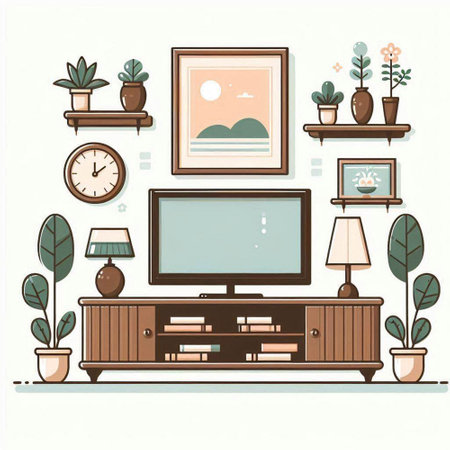Introduction to British Decluttering: Heritage Meets Modernity
The British approach to decluttering is a fascinating interplay between cherished heritage and the evolving rhythms of contemporary life. Across the UK, the way people organise and curate their living spaces reflects not only practical needs but also deep-rooted cultural influences. Traditional British homes often carry a sense of nostalgia, with heirlooms, classic furnishings, and collections that speak to family history and regional identity. These values have long shaped attitudes towards possessions, favouring sentimentality and the preservation of objects as a link to the past. However, modern lifestyles—characterised by urban living, smaller spaces, and a growing appreciation for minimalism—are prompting a fresh outlook on what it means to create an inviting home environment. As a result, there is an ongoing dialogue in British households about how best to balance respect for tradition with the desire for simplicity and functional design. This blend of old and new philosophies forms the backdrop for understanding traditional versus contemporary approaches to decluttering across Britain.
2. The Legacy of Traditional British Decluttering
Traditional British decluttering is deeply rooted in the nation’s social history and architectural landscape. In many classic British homes, space has always been at a premium, with limited built-in storage and compact room sizes dictating a careful approach to possessions. This has shaped a unique decluttering philosophy that balances sentimentality with practicality.
Generational Heirlooms and Sentimental Value
One of the cornerstones of traditional British decluttering is the preservation of generational heirlooms. Items such as antique furniture, porcelain tea sets, and inherited artwork are treasured not only for their monetary value but also for their connection to family heritage. These pieces are often carefully curated and displayed, rather than hidden away, reflecting a respect for ancestry and continuity.
The Influence of Limited Storage in British Homes
The typical British home, particularly those built before the 1970s, offers modest wardrobe space and minimal storage solutions. This scarcity has historically encouraged residents to be resourceful, keeping only what was necessary or truly cherished. The table below illustrates how this limitation has influenced traditional decluttering practices:
| Aspect | Traditional Approach | Reasoning |
|---|---|---|
| Storage Space | Minimal wardrobes, under-bed boxes | Maximising every inch due to small rooms |
| Possession Retention | Selective keeping (heirlooms, essentials) | Limited space fosters mindful selection |
| Decluttering Frequency | Seasonal or generational clear-outs | Linked to major life events or moves |
The Art of ‘Making Do and Mending’
A defining feature of traditional British attitudes towards decluttering is encapsulated in the wartime mantra: ‘make do and mend’. Rather than discarding worn items, families would repair clothing, reupholster old chairs, or repurpose containers. This culture of thrift not only reduced waste but also imbued household objects with stories and character.
Key Elements of ‘Make Do and Mend’ Culture:
- Resourcefulness: Creative reuse of materials for practical solutions.
- Sustainability: Valuing longevity over disposability.
- Aesthetic Adaptation: Blending patched fabrics or mismatched crockery into charming interiors.
This legacy of traditional decluttering continues to influence contemporary approaches in Britain today, offering valuable lessons in sustainability, emotional connection, and spatial ingenuity.

3. Modern Minimalism: Contemporary Approaches in the UK
The contemporary British approach to decluttering is deeply influenced by the global rise of minimalism, yet it maintains a distinctive local flavour. In recent years, UK households have increasingly embraced the mantra of “less is more,” moving away from traditional notions of abundance towards curated, functional living spaces. This shift is visible in popular British movements such as the “edit your life” philosophy, championed by local designers and lifestyle experts who advocate for intentional living and conscious consumption.
Global trends like Marie Kondo’s tidying method have found eager audiences in Britain, but these methods are often adapted to fit British sensibilities—emphasising practicality, sustainability, and respect for sentimental items. The influence of Scandinavian design aesthetics, with their emphasis on clean lines and natural light, has also permeated UK interiors, inspiring homeowners to create open, airy spaces that evoke a sense of calm and order.
Contemporary decluttering in Britain goes beyond simply clearing out excess possessions; it seeks to elevate everyday living through thoughtful spatial planning and the use of quality materials. The popularity of multifunctional furniture, hidden storage solutions, and neutral colour palettes reflects a desire for both beauty and utility within the home. Ultimately, these modern minimalistic approaches highlight a collective move towards mindful ownership and personal well-being—shaping a new standard for British homes that harmonises global inspiration with enduring local values.
Cultural Nuances: British Values and Sentimentality
When exploring the contrasts between traditional and contemporary British approaches to decluttering, it is essential to consider the profound cultural nuances that underpin both. At the heart of these methods lies a distinctly British sense of sentimentality—an enduring attachment to objects steeped in personal or family history. This emotional connection often influences decisions about what to keep and what to let go, shaping decluttering practices across generations.
Traditionally, British homes have been repositories for heirlooms, keepsakes, and inherited furniture—each piece telling a story or representing a cherished memory. The value placed on history and continuity means that many households are reluctant to part with items that evoke nostalgia or familial pride. Antique tea sets, portraiture, and handwritten letters frequently find themselves preserved not only for their material worth but for their emotional resonance. The act of decluttering in this context is often approached with caution, sensitivity, and a sense of duty to honour the past.
In contrast, contemporary British attitudes towards decluttering are increasingly influenced by modern design philosophies and a desire for functional, calming spaces. However, even as minimalism gains popularity, there remains a distinctively British way of weaving sentimental items into new interiors—often through thoughtful curation rather than wholesale disposal. This creates living spaces that feel both modern and rooted in heritage, where meaningful objects serve as focal points rather than clutter.
Comparing Traditional and Contemporary Sentimental Values
| Aspect | Traditional Approach | Contemporary Approach |
|---|---|---|
| Attachment to Objects | Strong; focus on preserving family history | Selective; emphasis on meaningful curation |
| Decision-Making Process | Emotionally driven; involves family consultation | Balanced between emotion and practicality |
| Role of Heirlooms | Central; displayed prominently in the home | Integrated selectively into modern décor |
| Decluttering Pace | Gradual; cautious and respectful | More dynamic; guided by lifestyle needs |
The Enduring Power of Storytelling in Spaces
Whether through traditional or contemporary lenses, British decluttering practices reveal a unique interplay between practicality and sentimentality. Even as tastes evolve, the inclination to honour stories embedded within objects persists—shaping homes that celebrate both personal legacy and modern living. Ultimately, the British approach recognises that true comfort lies not only in clear spaces but also in the memories those spaces hold.
5. Practical Strategies for British Homes
Decluttering in Britain is as much about respecting heritage as it is about embracing modernity. Whether you reside in a charming Victorian terrace or a sleek new-build flat, space is often at a premium and every inch counts. Below, we explore practical, culturally attuned strategies that honour both the unique quirks of period properties and the clean lines of contemporary living spaces.
For Period Properties: Cherishing Character While Creating Calm
Older British homes often come with architectural features like alcoves, ornate fireplaces, and sash windows that add undeniable charm but can complicate storage solutions. Embrace fitted shelving in awkward nooks to maximise vertical space without disrupting original detailing. Repurpose traditional items—think vintage trunks or antique dressers—as stylish storage, blending functionality with nostalgia. Retain beloved heirlooms by displaying them artfully rather than letting them clutter surfaces; curated vignettes on mantels or inside glass-fronted cabinets celebrate personal history while keeping rooms ordered.
For Modern Flats: Minimalism with Personality
Contemporary British flats frequently favour open-plan layouts and minimalist aesthetics. Opt for multi-functional furniture—ottomans with hidden compartments or wall-mounted desks—to maintain a streamlined look. Use neutral palettes as a backdrop for thoughtfully selected décor, allowing each piece to stand out without overwhelming limited square footage. Storage baskets made from natural materials and modular shelving units offer flexible, design-led options for everyday essentials. Always prioritise quality over quantity to achieve that effortless yet intentional British cool.
Blending Traditions: Best of Both Worlds
No matter the era of your home, decluttering in the UK means finding balance between preserving character and fostering serenity. Rotate seasonal items to avoid overcrowding wardrobes and hallways—a classic British habit given limited closet space. Regularly review possessions using the “one in, one out” rule, which encourages thoughtful curation in true British fashion. Above all, let your home reflect your story: incorporate family treasures alongside contemporary finds for a uniquely British sense of belonging and order.
6. Bridging the Gap: Mixing Old and New Methods
For those seeking to craft interiors that reflect both a reverence for British heritage and an appreciation for modern simplicity, merging traditional and contemporary decluttering approaches offers a uniquely personal path forward. Rather than choosing between the nostalgia of heirlooms and the clarity of minimalist design, consider strategies that honour both. Start by thoughtfully curating inherited pieces—such as a Victorian writing desk or a classic Welsh dresser—and giving them pride of place, while surrounding them with open space and subtle, functional accents. This allows historical objects to become meaningful focal points, rather than sources of visual clutter.
Embrace the British ethos of “make do and mend” by repurposing vintage items in creative ways—perhaps transforming old suitcases into storage solutions or using antique teacups as decorative plant holders. Pair these elements with clean-lined furniture and neutral palettes typical of contemporary interiors, ensuring each piece has room to breathe. Integrate storage that is both discreet and stylish, such as under-stair cabinetry or built-in shelving painted in soft Farrow & Ball hues, blending practicality with timeless charm.
Above all, approach your home as a living narrative—a reflection of your own story woven through layers of past and present. Carefully edit collections to highlight what truly resonates with you: display a few cherished family photographs instead of entire albums; feature select ceramics from a larger set. Balance tradition’s sense of rootedness with the liberating calm brought by modern orderliness. In this way, every corner of your space becomes both purposeful and poetic, creating an environment that is unmistakably yours—rooted in British character yet refreshed for contemporary life.

